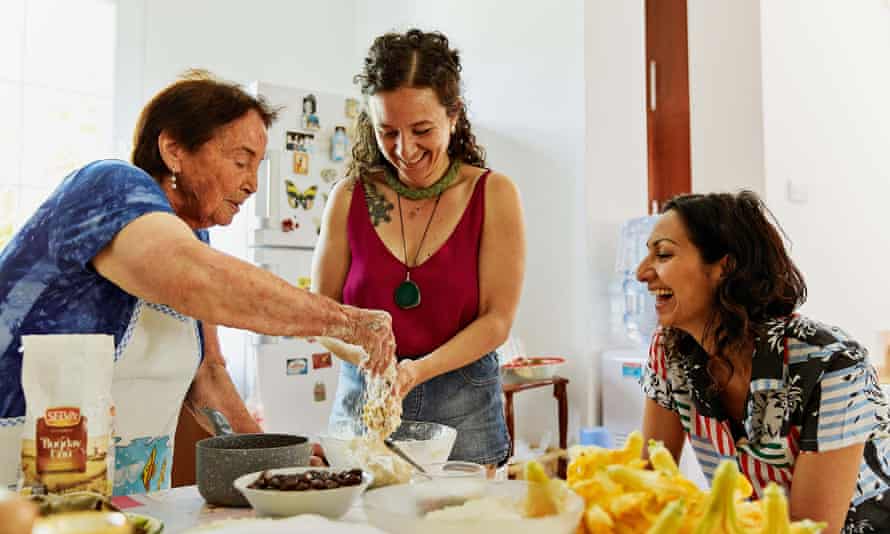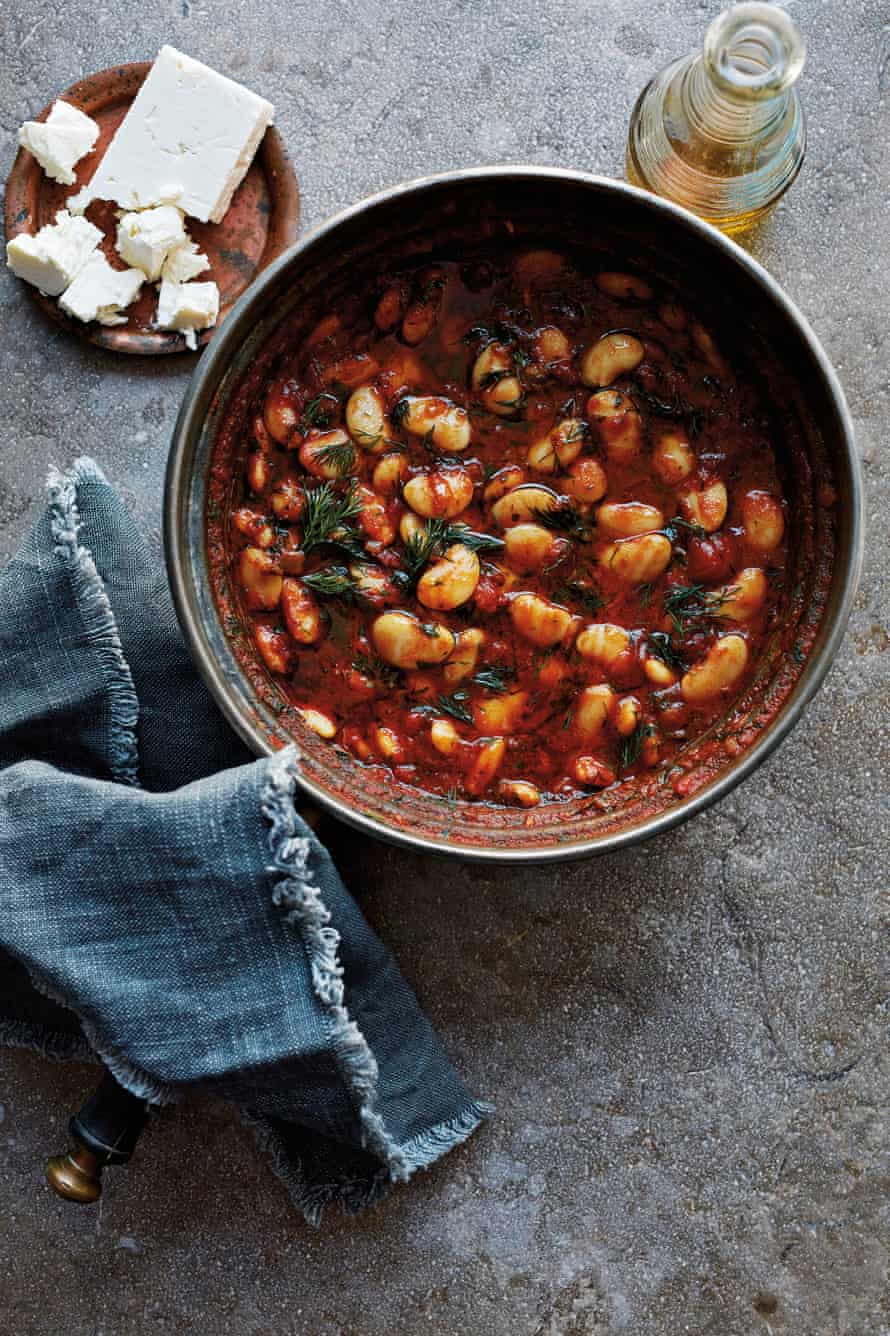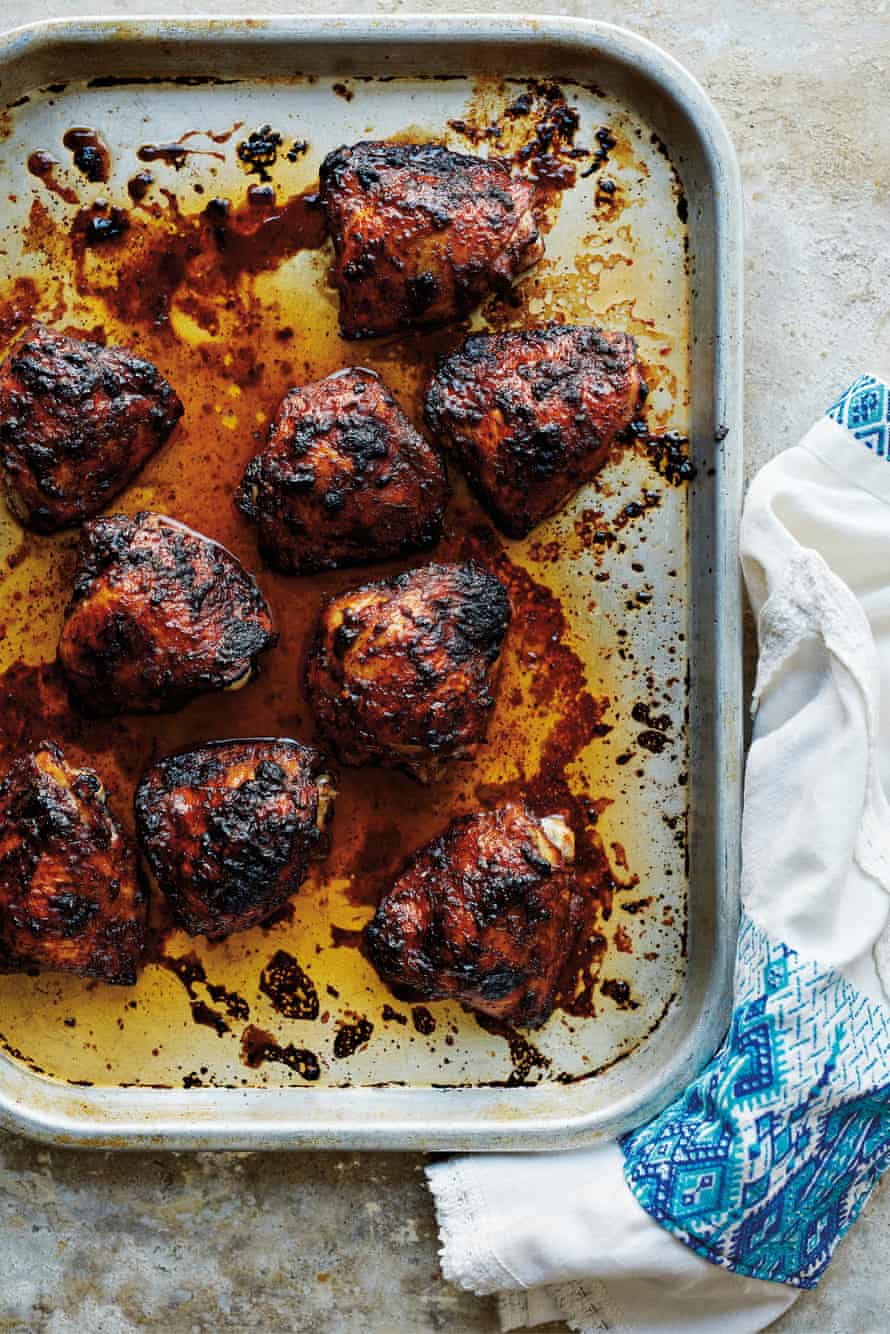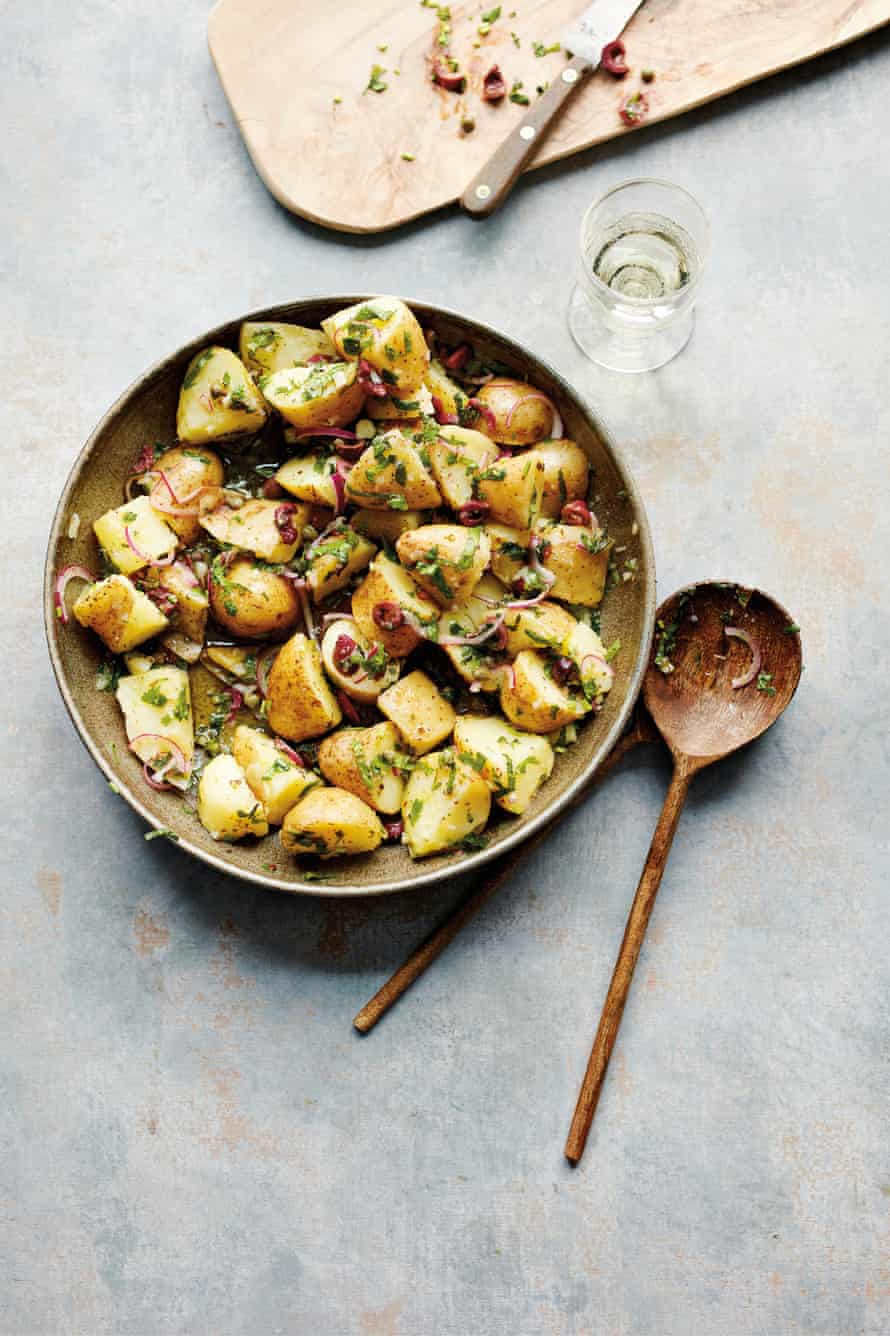How to Cook With No Stove or Oven - Food & Wine |
- How to Cook With No Stove or Oven - Food & Wine
- Yasmin Khan’s new recipes: cooking in refugee camps from Greece, Turkey and Cyprus - The Guardian
- Campfire cooking: The flames add flavor | Food and Drink | readingeagle.com - Reading Eagle
- Updated No-Knead Bread Recipe - NYT Cooking - The New York Times
|
How to Cook With No Stove or Oven - Food & Wine Posted: 03 May 2021 08:07 AM PDT |
|
Yasmin Khan’s new recipes: cooking in refugee camps from Greece, Turkey and Cyprus - The Guardian Posted: 04 May 2021 03:02 AM PDT Two stories in Yasmin Khan's cookbook Ripe Figs tell the story of the power of food. In the first, Khan recounts how Greek volunteers started bringing containers of food for migrants who were sleeping in a park – but insisted on the food being homemade. "We wanted to convey the message that somebody cares about you. Cares enough to spend their afternoon baking a cake that smells or feels like home," explained Nadina Christopoulou, one of the founders of the initiative. Second is the story of Home for All, a restaurant on the banks of a fishing port on the edge of the Gulf of Yera in Lesbos where, every day, 40 immigrants are brought from some of the most notorious and violent refugee camps to eat at a restaurant that is bright, communal, and full of life. "Being able to eat in this comfort, at a table, with proper cutlery, it restores people's dignity, it reminds them who they are. It makes them feel like home," said Katerina Katsouris, who co-owns Home for All with her husband. Those acts of care are what inspired Khan, the chef and author of Zaitoon, to take a trip to Greece, Turkey and Cyprus to cook in refugee camps. She saw how one 's humanity can be restored over a plate of food; a glass of wine; a conversation at a shared table. The cookbook focuses on the similarities between the foods from each place. That way, writes Khan "you can begin to see similarities where political borders insist upon division and difference". Responses have been edited for clarity and length.  You say you want this book to open people's eyes to the migrant crisis. Why did you think a cookbook would be a good place to bring this topic alive? Food is an incredibly powerful vehicle for helping us understand ourselves, and the world around us. When you learn about food, you don't just learn about a set of ingredients, you learn about history, geography, migration. For many years I was a human rights campaigner, working on issues ranging from police shootings to the blockade of Gaza. What I learned was when you're trying to raise awareness of quite heavy political issues, the most important thing to do is to try and build a connection. Food is such a wonderful way of connecting people, because it's so visceral, something we can all relate to. In the US and the UK there's often an attitude around migration that 'We don't have enough'. You find people who really don't have much opening their arms – and not just saying, 'We're going to give you a sandwich', but 'We're going to make sure every single thing we give you is homemade'. Talk to me about that difference. Turkey is the biggest recipient of refugees in the world, there are 3.6 million refugees in Turkey. In 2020, the US, settled just under 12,000. The way refugees and migrants have been used as scapegoats by political leaders on both sides of the Atlantic doesn't really reflect the numbers of people moving to these countries, nor the fact that migration is just an essential part of what it means to be human. Throughout our history, we've always moved for our survival. You mention in the book that you chose recipes from Greek, Cyprus and Turkey to focus on similarities between places where governments insist on seeing difference. Absolutely. Borders are completely a manmade construct. The very notion of nation states is a very recent one in human history – we're looking at a few hundred years mostly. I just wanted to pull right back and look at the region, where we don't see artificial lines and try to, yes, celebrate the commonalities. You believe in open borders. We do have open borders for a section of society. The rich can move very easily. Cyprus is a classic example: on the one hand, you've got refugees making perilous journeys on choppy waters and small boats, trying to get to the island and then potentially being put in a camp. And then, for others, there are [investor citizenship schemes] where, if you invest €2m into Cyprus, you can buy a European passport. In a lot of western democracies, especially in the US and the UK, there's often a presumption that good food is a luxurious or a middle class preoccupation – a rich people thing. I wonder what you think of that mindset? I'm of mixed heritage: my mom's from Iran, my dad's from Pakistan. My family are small-scale farmers in the north of Iran. Food is such a huge occasion for celebration in my family. Every meal – whether breakfast, lunch or dinner – is one of the highlights of the day. Sometimes people ask me, wasn't it difficult talking to people about food in this really challenging circumstance? No, of course, it wasn't, it was really fun! In [some places], people live to eat and the concept of food is about a broader concept of community. That's wonderful. Food is like a universal language that enables you to communicate feelings of empathy, of connection, of hope, of love. What do you hope this book will open people's eyes to? That there isn't some kind of migration crisis – this is just what happens when you put up fences and walls. It is the wrong response. As long as humans have existed, we have travelled, and migration has been an intrinsic part of survival. I just hope the book fosters greater understanding and empathy for refugees and migrants so that we can start coexisting in a shared planet, in the way we deserve to. Smoky lima beans - gigantes plaki This is one of those punchy pantry recipes that is easy to whip up as a midweek meal and takes its inspiration from a traditional Greek dish of beans baked in a tomato sauce. What gives this dish its unique flavor is the paprika (I add both the smoked and sweet versions, not the hot and spicy type), which adds a richness and earthiness that I find irresistible. I alternate between sprinkling crumbled feta on top of this dish and having it plain, as it's just as delicious without. Serve warm or at room temperature. Prep 10 min 3 tbsp vegetable oil Heat the vegetable oil in a large saucepan. Add the onion and gently fry over medium heat for 12 to 15 minutes until soft. Add the garlic and cook for another few minutes, then add the tomatoes, sugar, oregano, both types of paprika, cinnamon, 1 teaspoon salt, and a generous grind of black pepper. Cover and simmer for 15 minutes. Add the beans to the tomato sauce with the hot water and another ½ teaspoon salt. Cover and cook over low heat for 30 minutes. Stir in the extra-virgin olive oil and herbs and cook for a final five minutes. Taste, adjust the seasoning, and sprinkle with more herbs, and crumbled feta if you fancy it, just before serving. Pomegranate and sumac chicken This is an easy chicken sheet pan recipe inspired by a Syrian meal I ate at Reem, a restaurant on the Greek island of Lesvos run by Mahmud Talli. A Syrian doctor who managed to escape the war, Mahmud found himself trapped on the island after seeking refuge there, and soon put all his efforts into helping to provide services for new arrivals to Lesvos volunteering at a local community kitchen and establishing his restaurant. This sticky roasted leg of chicken can be marinated ahead of time and just popped into the oven shortly before eating. If you don't want to use chicken thighs, this also works with a whole chicken, jointed into eight pieces. Prep and marinate 3 hr 30 min 8 large chicken thighs, skin-on, bone-in Place the chicken in a large bowl and pour all the ingredients (except the olive oil) over it with 1½ teaspoons salt and ½ teaspoon black pepper. Using your hands, massage this into the chicken until it is evenly coated, then cover and place in the refrigerator to marinate for at least 3 hours. When you are ready to eat, take the chicken out of the refrigerator and let it come to room temperature (this will take about 20 minutes). Preheat the oven to 200C/390F/gas 6. Place the chicken on a rimmed baking sheet and drizzle with the olive oil. Transfer the sheet to the oven and roast for about 35 minutes, or until the juices from the chicken run clear when it is pierced at the thickest part. Cypriot potato salad A zesty, herb-packed potato salad, perfect for serving alongside grilled meats or fish. Try to use kalamata olives here, but, if you can't find those, just aim for the olives to be oily rather than briny in these dishes. Be sure to toss the dressing in while the potatoes are still warm, as they absorb the flavors better. Prep 10 min 1kg Cyprus or new potatoes 1 tsp dried oregano Cut the potatoes into large (5cm) chunks. I like to leave the skins on, but remove them if you prefer. Bring a large saucepan of water to a boil. Add 1 teaspoon salt and the potatoes to the pot and boil for about 12 minutes until they are soft. Drain and place in a serving bowl. Add all the remaining ingredients along with ¼ teaspoon salt and a generous grind of black pepper. Recipes reprinted from Ripe Figs: Recipes and Stories from Turkey, Greece, and Cyprus, published by W W Norton & Company. |
|
Campfire cooking: The flames add flavor | Food and Drink | readingeagle.com - Reading Eagle Posted: 03 May 2021 02:30 AM PDT  The last time my Boy Scout troop went on a campout, we ate steak. I was startled. I was shocked. I didn't know you could do that on a campout. Before that, most of our previous experiences around a campfire somehow involved Spam. We also had a memorable night in which we ate hamburgers with the ground beef stretched by adding bread, which our troop leader informed us was to add flavor. Our troop leader's name, incidentally, was Norman Bates. Despite sharing a name with the notorious psycho in "Psycho," he was a nice guy. He was so nice, he bought steak for our last campout. So perhaps my concept of eating around a campfire has been skewed. I always thought it meant Spam, with occasional sightings of hamburger and, on the rarest of occasions, steak. But apparently things have changed in 50 years. Now, some people drive to a campsite in campers equipped with all the comforts of a four-star hotel. Others' tastes have expanded beyond the bounds of hot dogs, hamburgers and Spam to encompass dishes with more creativity in their cooking. I recently camped out in the wilds of St. Louis' Tower Grove East neighborhood, where I encountered exotic wildlife (squirrels) and experienced the mysterious sounds of nature (the friendly barking of the dogs next door, Florence and Moby). I also cooked up a mess of chow around the old campfire, which I guess would technically be called a "grill." But still, the recipes will work for campfires, too. I began, as one does, with breakfast. I made Campfire French Toast, which just may be the best French toast ever. And that's not just because you get the faintest hint of smoke in your toast (OK, you can't really taste it at all, because it's wrapped in foil), but it's also because the recipe is so stunning. And rich. Usually, you use whole milk to make French toast, but it can be a hassle to bring milk with you on a camping trip. It's so much easier just to use a can of evaporated milk, which, I see now, has more calories — even nonfat evaporated milk. But you could use regular milk and still be impressed by this superlative dish, because it also calls for a fair amount of cinnamon and vanilla, plus a bit of maple syrup right in the dipping mixture. These are the magic ingredients that make any French toast better, especially when paired with multigrain bread. I used the same loaf of bread to make Bacon, Egg and Avocado Toast. Or that's what I would have made if I had remembered the egg. As it was, I made Bacon and Avocado Toast. And that was excellent, too, because of certain irrefutable fact: Bacon tastes better when it's cooked over a fire. Though it is smoked to begin with, bacon only improves from a little extra fresh smoke from the glowing embers of a campfire. Toast, too, tastes better when cooked directly on the grate over a fire. Don't cook the avocado. And if you do happen to remember the egg, simply cook it in the pan you used for the bacon. But frankly, the sandwich I made was so good it did not need an egg. The next dish I made is so obvious I'm embarrassed that I never thought of it before — quesadillas cooked over a fire. Like the French toast, the secret is to cover it in foil. Once protected from the fiercest heat of the fire, the quesadilla has a chance to warm up slowly until the cheese reaches the ideal state that scientists refer to as "gooey." You can put anything in a quesadilla, but I stuck to the basics: precooked chicken, black beans, salsa and shredded cheese. When you're cooking over a campfire, you don't want to get too fancy. Unless you're making shrimp scampi. If you happen to have the ingredients for shrimp scampi at your next campout, you may as well make it. It's actually a simple, unassuming dish, but it is as delicious to eat at a campfire as it is unexpected. Once again, the key is to use foil. Just divide the ingredients — shrimp, garlic, white wine or chicken stock, butter, red pepper flakes, lemon juice and a bit of salt — into foil pouches, seal the pouches tight and put them on the grate. Foil, of course, is notoriously nontransparent. And because shrimp are so quick to cook, you'll have to open the pouches a few times to see if they are done. But this slight effort does not matter, because the results are so worth it: shrimp scampi, on a camping trip. Imagine that. Naturally, any time spent around a campfire must include s'mores, but I decided to mix things up and make savory s'mores. That is, I stuffed mushroom caps with blue cheese and wrapped then with bacon. Perhaps you have had dates stuffed with Parmesan and wrapped with bacon. These savory s'mores are a variation on that life-changing idea, and you get the extra benefit of the smoke-enhanced bacon. Bacon, mushrooms and blue cheese. It's the ultimate appetizer. It's almost worth going camping for. ——— CAMPFIRE QUESADILLAS Yield: 4 servings 4 flour tortillas, medium size (7 inches) 8 ounces cooked chicken (from about 12 ounces raw) 1 cup canned black beans, drained and rinsed 1 cup salsa 1 cup shredded Mexican blend cheese 1. Place each tortilla on a large piece of heavy-duty aluminum foil and place chicken on half of each tortilla. Top with equal amounts of beans, salsa and cheese. Fold tortilla over and fold foil over tortilla, but do not seal the edges. 2. Place foil packets on the grate over a fire and cook, flipping occasionally, until cheese has melted and tortilla is moderately browned and crisp. Per serving: 392 calories; 13 g fat; 5 g saturated fat; 68 mg cholesterol; 28 g protein; 40 g carbohydrate; 3 g sugar; 5 g fiber; 821 mg sodium; 311 mg calcium Recipe by Daniel Neman, adapted from a recipe by cupcakediariesblog.com SAVORY S'MORES Yield: 4 servings 8 ounces mushrooms, preferably with large caps 1 1/2 ounces blue cheese 8 ounces bacon 1. Clean mushrooms and remove the stems. Fill caps with blue cheese and wrap with bacon so the bacon covers the cheese. Secure with a wooden toothpick. 2. Place wrapped mushrooms on a grate over a fire. Cook, occasionally turning carefully with long tongs, until bacon is done. When turning, try to keep melted cheese from dripping out (but don't worry; it will still taste good). Per serving: 284 calories; 26 g fat; 10 g saturated fat; 45 mg cholesterol; 11 g protein; 3 g carbohydrate; 2 g sugar; 1 g fiber; 466 mg sodium; 61 mg calcium Recipe by Norma Klingsick CAMPFIRE FRENCH TOAST Yield: 4 servings 3 tablespoons unsalted butter, melted 1 (12-ounce) can nonfat evaporated milk or 1 1/2 cups whole milk 2 large eggs 2 tablespoons pure maple syrup, plus more for serving 2 teaspoons pure vanilla extract 1 teaspoon ground cinnamon 8 slices multigrain bread 1 cup mixed berries, optional 1. Spray 8 (14-inch) pieces of heavy-duty foil with nonstick spray, or use nonstick foil, and brush the center of each piece with melted butter. 2. Whisk together the evaporated milk, eggs, maple syrup, vanilla and cinnamon in a small baking dish or large resealable bag. If you don't have a whisk, use a fork. 3. Dip both sides of each piece of bread in the milk mixture until fully submerged. Arrange 2 pieces of bread next to each other, without overlapping, on 1 piece of buttered foil. Repeat with the remaining bread and 3 pieces of foil. 4. Make the foil packs: Put the remaining 4 pieces of foil, buttered-side down, directly on top of the bread so the foil touches the bread and the edges line up. Fold and crimp the edges tightly to make 4 rectangular packets. 5. Place the packs on a grate over a medium-hot fire and cook about 5 minutes on each side. Cooking time will depend on the heat of the fire and the distance of the packs above the embers, so check for doneness by carefully opening one of the packs (hot steam will escape). The French toast is done when it is browned on both sides and the center is custardy. Keep in the packets or transfer to plates. Top each serving with 1/4 cup of the berries, if using, and more maple syrup. Per serving: 321 calories; 13 g fat; 7 g saturated fat; 117 mg cholesterol; 13 g protein; 37 g carbohydrate; 16 g sugar; 5 g fiber; 262 mg sodium; 166 mg calcium Adapted from a recipe by the Food Network SHRIMP SCAMPI Yield: 4 servings 4 garlic cloves, minced 2 tablespoons dry white wine or chicken broth 1/8 teaspoon (2 large pinches) salt, or to taste Pinch crushed red pepper flakes, or to taste Black pepper, to taste 2 tablespoons lemon juice 1 1/2 pounds shrimp, shelled 2 tablespoons butter, cut into 4 pieces 1 tablespoon chopped parsley 1. In a small bowl, mix together garlic, wine or broth, salt, crushed red pepper, black pepper and lemon juice. 2. Divide shrimp onto 4 large pieces of heavy-duty aluminum foil, and sprinkle evenly with garlic-wine mixture. Top each portion with 1 piece of butter, and sprinkle with parsley. Fold foil over each shrimp mixture and fold edges to seal tightly. 3. Place foil packets on a grate over a fire and cook, flipping occasionally, until done. Cooking time will vary depending on the size of the shrimp and heat of the fire, but remember that shrimp cook quickly. Periodically open a packet to check doneness; shrimp are cooked when they are pink and curled. Per serving: 268 calories; 13 g fat; 7 g saturated fat; 304 mg cholesterol; 34 g protein; 3 g carbohydrate; 1 g sugar; 1 g fiber; 278 mg sodium; 123 mg calcium Recipe by Daniel Neman BACON AND AVOCADO TOAST Yield: 1 serving 2 slices multigrain bread 2 strips bacon 1 small ripe avocado 1 wedge lemon Salt and pepper 1. On a grate over a campfire or grill, toast bread on both sides. 2. Place a cast-iron skillet over the fire and cook bacon; watch carefully to keep from burning. Cut avocado in half, remove the pit and scoop out the middle; mash it with a fork in a small bowl. Spread the avocado on one piece of toast, sprinkle with the juice of the lemon and season well with salt and pepper. Top with the bacon and the other piece of toast. Per serving: 606 calories; 46 g fat; 11 g saturated fat; 37 mg cholesterol; 17 g protein; 37 g carbohydrate; 5 g sugar; 14 g fiber; 735 mg sodium; 85 mg calcium Recipe by Daniel Neman ©2021 STLtoday.com. Distributed by Tribune Content Agency, LLC. |
|
Updated No-Knead Bread Recipe - NYT Cooking - The New York Times Posted: 03 May 2021 03:00 PM PDT  This recipe is based on Jim Lahey's recipe from 2006, with a few modifications for the sake of precision and a touch of acid to improve dough strength. Unlike Mr. Lahey's recipe, this one does not require handling a hot Dutch oven. You'll need one metal heatproof bowl (no rubberized bottoms) around 11 to 12 inches in diameter, a second bowl of any material around 8 to 9 inches in diameter, a scale with gram-accurate resolution, a baking sheet and a clean cotton dish towel. (Freshly washed is fine; it doesn't need to be brand new.) If you prefer, you can still bake in a Dutch oven instead of using the overturned bowl method described in the steps; see the story for full details. |
| You are subscribed to email updates from "cooking" - Google News. To stop receiving these emails, you may unsubscribe now. |
Email delivery powered by Google |
| Google, 1600 Amphitheatre Parkway, Mountain View, CA 94043, United States | |
from What to Cook https://ift.tt/3ti0cMD

